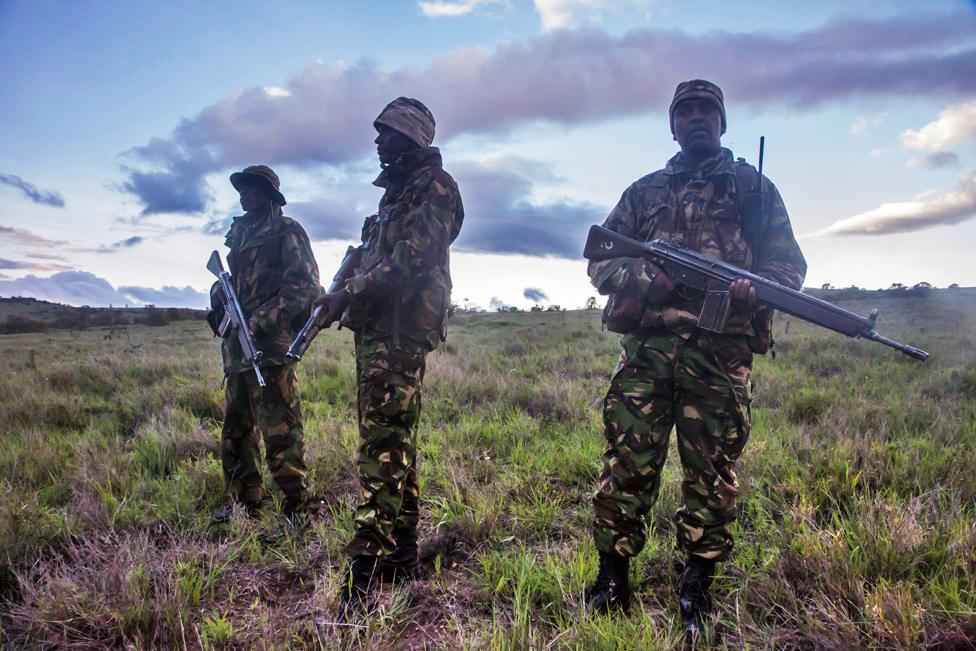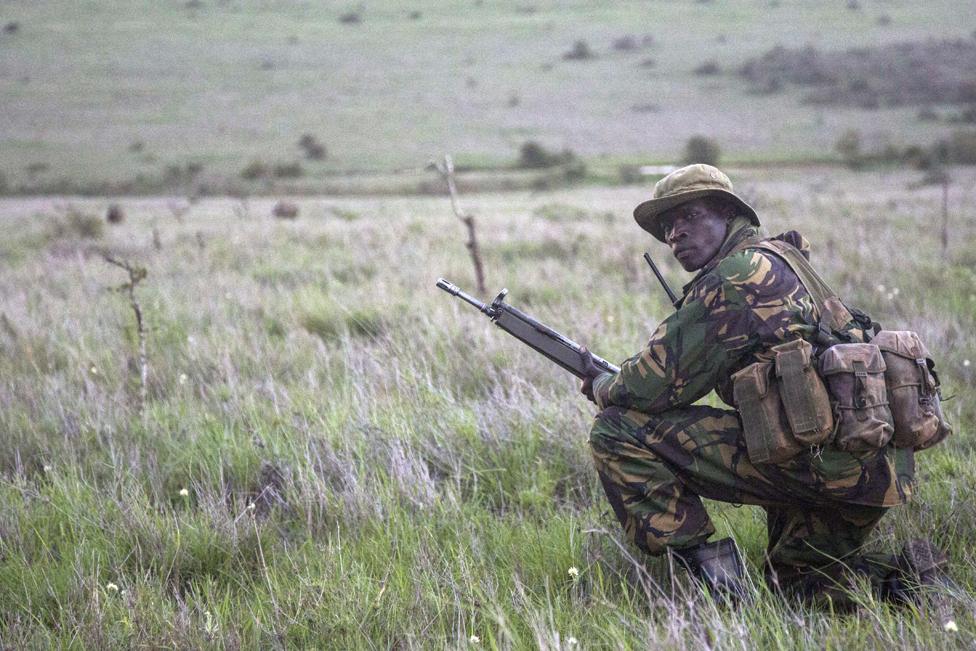The snipers trained to protect rhinos
- Published

In Kenya's Borana nature reserve, drastic new measures are being taken to protect vulnerable rhinos from poachers who kill the animals for their horns, writes Chris Haslam.
You never expect Africa to be cold, but up here on Kenya's Laikipia plateau, it's freezing. Thick cloud hides the spires of Mount Kenya and as darkness falls, the temperature plummets.
I'm lying in wet grass with three heavily armed Kenyans. One hundred metres ahead stand three white rhinos. They're oblivious to our presence, and from here, with three shots, my companions could earn themselves a year's salary each.
But they won't. They're part of an SAS-trained private army raised to protect the species from poachers. I ask the sergeant what he would do if he spotted one of his friends or neighbours up to no good.
His reply is unequivocal. "If he comes to kill rhinos he is robbing the entire community. And I will shoot him dead."
There used to be 200,000 of the myopic beasts here in Kenya. That number collapsed to around 200 in the mid-80s, but with the establishment of sanctuaries, the population has recovered to around 600.

Find out more

From Our Own Correspondent has insight and analysis from BBC journalists, correspondents and writers from around the world
Listen on iPlayer, get the podcast or listen on the BBC World Service or on Radio 4 on Thursdays at 11:00 and Saturdays at 11:30

The Lewa and Borana conservancies - 375 sq km (145 sq miles) of windswept former cattle country - form one of those sanctuaries. Vulnerable rhinos, both white and black, were relocated here from 1984 onwards, but then the poachers found them.
"We lost 17 from a population of 90," says Borana's Michael Dyer. "We were outgunned and outwitted, so we had to up our game."
Dyer recruited a former Special Forces instructor from the British army to train a hand-picked militia of local men, then gave them to right to use lethal force by enrolling them as Kenya police reservists.
"They operate in four-man teams comprising a sniper, two riflemen, and a signaller," says Dyer. "They've got night vision gear and digital radios so if they need to, they can call in ground and air support."

The teams monitor 102 rhinos, but when they spot poachers, they don't arrest them. They don't even invite them to lay down their arms. Instead, they kill them - 19 so far, in split-second ambushes during which their victims probably never knew what hit them.
Dyer says this is the safest way to deal with men facing 25 years in prison if convicted.
"Technically we do have to offer them the opportunity to surrender," he adds, "but this tends to happen after they've been, er, incapacitated."
And it works. The poachers, who can earn $21,000 (£15,000) for a 9kg (20lb) horn worth $570,000 (£400,000) in Hanoi, haven't given up, but last year not a single rhino was poached on the Lewa conservancy. Borana lost just one, shot in July. But doesn't the use of a private army, raised by rich white men to shoot poachers on sight, raise worrying questions of legality and ethics?
Dyer dismisses the question. "The rhinoceros has been on this planet for five million years," he says. "If we don't protect it, then who will?"

Tourists on safari look at white rhinos at the Nakuru National Park in Kenya
The local community, which benefits from tourism, seems to agree.
"Poachers are bad people," says one herder. "Sometimes we see them in town. Poor men who are suddenly rich. They cannot spend that money here. We will force them to leave."
Despite pleas from celebrities and royalty, the appetite for horn - a status symbol believed to cure everything from hangovers to cancer - is growing. Every rhino in Lewa and Borana is a potential target, and that means each animal needs round-the-clock protection.
As Dyer puts it, "trying to keep rhinos alive only loses you money."
Out in the bush, the sergeant gives a hand signal and we withdraw - three silent killers and one clumsy journalist.
"Even with you, the rhinos did not know we were there," whispers the corporal. "Now you see how easy it is for the poachers."

Boda bodas - the cheap motorcycles imported from China - have made it even easier. Getaway drivers use them to ferry gangs into the bush, where cached weapons are retrieved for the hunt.
Once the animal is down the poachers close in, hacking, sawing and gouging the horn from its socket. A recent trend has been to leave a flap of facial skin attached to the horn. To the connoisseurs of Hanoi and Beijing, it proves terroir and vintage - the equivalent of the label on a fine bottle of wine
The team is still upset about that rhino killed last July. "We heard the shot," says the sergeant, "but we didn't know what direction it came from. By the time we found the carcass, the poachers had gone."
Next time, there may be no shot. "The poachers are learning," says the rifleman. "Now they are using bows and poison arrows."
I suggest that this might make them easier to arrest, but the sergeant shakes his head. "We will still kill them," he says.
Photographs, unless indicated, courtesy of Chris Haslam

More from the Magazine

In 2014, a record 1,215 rhinos were slaughtered for their horns in South Africa - and at the same time, 42 poachers were killed by rangers and police. This bloody conflict is fuelled by the mistaken belief in Asia that rhino horn cures cancer, and it's growing more intense every year.

Subscribe to the BBC News Magazine's email newsletter to get articles sent to your inbox.